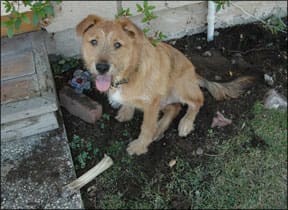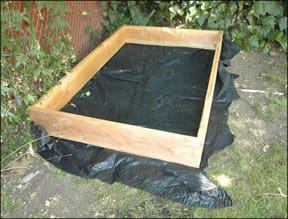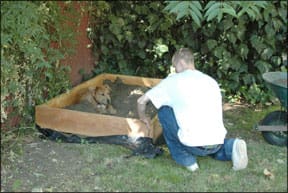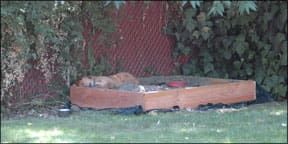[Updated August 9, 2017]
DIRT-DIGGING DOGS OVERVIEW
– If your dog likes to dig and you have a yard with a bit of room, build a sandbox for him!
– Keep the sand damp; it makes it more inviting to dig in.
– Bury some of his toys in the box, and encourage his digging there.
– Cover the box at night if there are cats around; you don’t want it used as a litterbox.
The perfect storm, canine edition: Combine one dog who is accustomed to and prefers spending time outdoors; a spate of hot, dry weather; a lush, productive garden full of herbs and tomato plants growing in raised boxes full of expensive, loamy soil and moistened three times daily by an automatic drip system. What do you get? Holes dug in the garden and an irate husband!

Our new dog, Otto, nearly made himself quite unwelcome on his second day in our home. Every time I turned around, I’d find him digging in any place we’d recently watered, including the lawn, a flowerbed in front of the house, underneath a gorgeous hydrangea bush that’s already hard-pressed to survive our hot summers, and, most seriously, the vegetable beds in back. “Can’t you train this dog not to dig?” my husband implored.
But this wasn’t a training issue; I’ve been trained enough by Pat Miller and our other contributing trainer/writers to recognize a management situation when I see it!
Dog Training vs. Dog Management
Training is the right thing to do when you want to get a dog to do something specific: fetch a ball, sit when greeting people, walk calmly on leash. But when you would like a dog to not do something – especially when you’d like him to not do it in your absence – you need to manage the situation.
For example, if a dog gets into and eats stuff out of the kitchen garbage pail, you could try to “catch him in the act” and punish him for it, or set up booby traps that would accomplish the same thing. Unfortunately, dogs generally have more idle time on their hands than we do; these approaches take more time and surveillance skills than most of us possess. Traps and stakeouts are unlikely to be successful, anyway; with a random reinforcement of some tasty old food, most dogs are motivated to persist through whatever traps or punishment they occasionally are subjected to. It makes far more sense to manage the situation by putting the pail in a location where he can’t possibly get into it (under the sink, say, with a baby-proof latch on the cupboard door).

Make a Compromise with Your Dog
Management solutions are most successful if they both A) absolutely prevent the dog from being rewarded for doing the thing you don’t want him to do, and B) reward him for doing something else. Unless we keep Otto inside (which he really doesn’t enjoy, and seems to encourage him to chew on household items), build a kennel on a concrete slab, or cover our entire lot in concrete, we can’t prevent Otto from digging. Fortunately, we have room in our yard to try Plan B: to give him a rewarding experience doing what he wants to do, but in a location of our choice.

It was clear to me that Otto wasn’t just digging for the fun of digging; he wasn’t burying toys or looking for gophers. Rather, he was trying to find a cool, damp place to beat the hot, dry weather we have all summer long in this part of California. Once he got a hole dug, he’d circle and hunker down in the hole for a nap. I proposed that we provide Otto with an especially cool, damp, shady spot where he could dig and snooze to his heart’s delight.
Doggie Sandbox Methods and Materials
Otto is a good-sized dog, about 50 pounds and fairly long. We wanted the box to be big enough for his digging and relaxing pleasure. After measuring his stretched-out length, we decided the ideal size would be 4 feet by 6 feet, and so we bought two 10-foot boards from which to make the frame. We also decided that 10 inches would be deep enough (he really didn’t dig very deep, just wide, when he dug), so we used boards that were 2 inches by 10 inches, in a low-cost ($8.50 each) variety of fir. We could have spent more for prettier (and rot-resistant) redwood, or used long-lasting pressure-treated wood, but since we didn’t know for sure if this solution would work, I felt the low-cost way was the best way.

My stepson Clark cut the lumber into 4-foot and 6-foot pieces, and screwed the ends together (as shown below) and I took our truck to buy some sand. I had phoned ahead to make sure that the landscape supply center had clean “sandbox” quality sand; not construction-grade stuff for mixing into concrete. One-half of a cubic yard filled our box perfectly, cost $20, and was well within the safe carrying capabilities of our little Ford Ranger pickup.
Doggie Sandbox Success!
The box was a smash hit with Otto before it was even completed. I had barely begun filling the box with sand when Otto got in, and he didn’t get out until hours later. Best of all, a month later, it’s still his favorite place to spend a hot day – and he’s dug another hole in the garden only once. He stays relatively clean (compared to when he was sleeping in damp soil), and though he has thrown a lot of sand out of the box, its out-of-the-way location means it’s fine by us.

If he hadn’t taken to his sandbox so quickly, I was prepared to spend time with Otto in the box, give him treats and praise for hanging out there, and perhaps show him how to bury and dig for some of his favorite toys. None of these were necessary – but building sand castles, just for the fun of watching Otto happily dig them apart, has proven to be a blast.







I have a small but slightly long fox terrier/Chihuahua mix who has taken to digging or scratching up a patch of lawn. So do you think the sandbox solution would work in a similar situation?
Copper loves our yard. We landscaped our yard with a beautiful lawn which was sodded for about three weeks and completed by February or March this year. While there were some grass burns, he really didn’t dig yet. It wasn’t until the past few months that the problem started. It wasn’t until after attempting to repair the burn patches by using some dog urine treatment spray, seeding, fencing it off with the wire corral gates and removing it when blades of grass were growing that this behavior began. He’s ruined any hard work I did for said repair and dug it and continues to dig it up. Now the lawn has gotten worse than it was and Copper has found a new source of frustrating entertainment.
Do you think the sandbox might work and how large does he need it. I might try it with a temporary kiddie sandbox or small plastic pool to see. The other option is artificial turf for him to urinate and scratch on (although it doesn’t really address the digging problem. HELP!